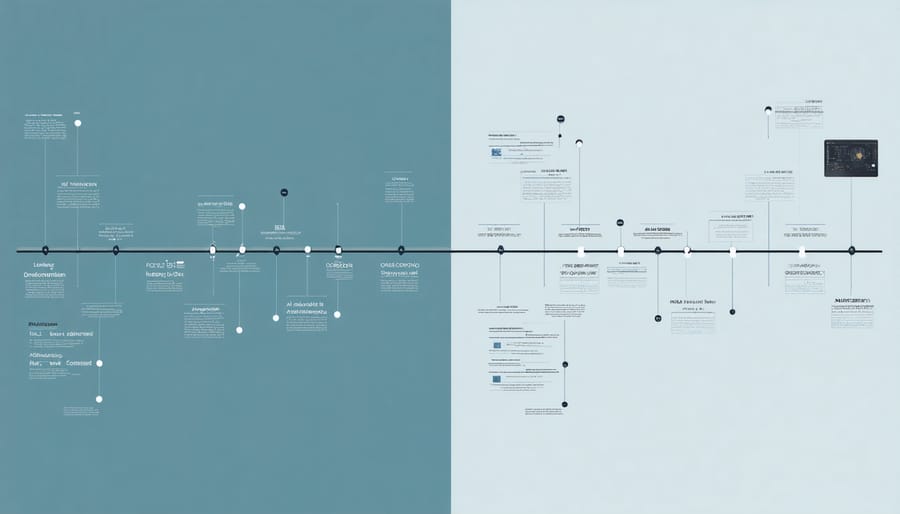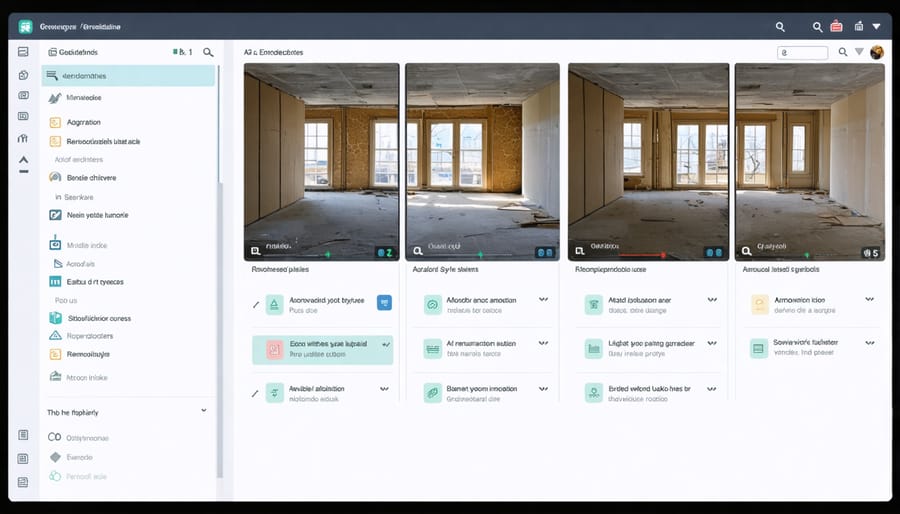
AI Project Management Tools That Actually Save Time (Not Waste It)
Transform your home renovation journey with AI-driven automation that revolutionizes how you plan your renovation project. Smart project management systems now analyze thousands of successful home improvements to predict timelines, costs, and potential challenges before you begin. Virtual design assistants generate personalized room layouts and material recommendations based on your style preferences, budget, and space constraints, eliminating countless hours of manual planning. Real-time automation tools coordinate contractors, track material deliveries, and adjust project schedules instantly when delays occur, keeping your renovation on track and within budget.
This technological evolution in home improvement isn’t just about efficiency – it’s about creating smarter, more personalized spaces while reducing the stress and uncertainty typically associated with renovation projects. From automated material ordering to AI-powered design validation, these tools put professional-grade project management capabilities into homeowners’ hands, making complex renovations more accessible and manageable than ever before.
Smart Timeline Management That Adapts to Your Projects

Real-Time Schedule Optimization
AI-powered scheduling tools are revolutionizing how renovation and design projects are managed, offering dynamic adjustments that traditional project plan templates simply can’t match. These smart systems continuously monitor project progress and automatically adjust timelines based on real-world conditions and unexpected changes.
For instance, when a paint delivery is delayed, the AI instantly recalculates the entire schedule, shifting dependent tasks like furniture installation while maintaining optimal workflow. It can even suggest alternative solutions, such as reorganizing the work sequence to focus on different rooms or recommending readily available paint alternatives.
Weather forecasting integration allows the system to preemptively adjust exterior work schedules, ensuring tasks like deck installations or outdoor painting are scheduled during optimal conditions. The AI also learns from past projects, becoming more accurate in estimating task durations and identifying potential bottlenecks before they occur.
For contractors and homeowners alike, this means fewer delays, better resource allocation, and more realistic completion dates. The system can even account for contractor availability, material lead times, and local permit processing periods, providing a truly comprehensive scheduling solution that adapts in real-time to keep your project on track.
Automated Resource Allocation
AI-driven automation has revolutionized how contractors and project managers handle resource scheduling and material management. The system analyzes historical project data, weather patterns, and contractor availability to create optimized work schedules that minimize delays and conflicts. When one contractor finishes their task, the AI automatically notifies the next team, ensuring smooth transitions between different phases of work.
For material deliveries, AI systems track inventory levels and project progress in real-time, automatically triggering orders when supplies run low. This predictive approach prevents costly delays caused by material shortages and reduces waste from over-ordering. The system can even adjust delivery schedules based on factors like weather forecasts and traffic patterns to ensure materials arrive exactly when needed.
What’s particularly impressive is how these AI systems learn from each project. They identify patterns in delivery times, contractor performance, and material usage, continuously improving their predictions and recommendations. For homeowners, this means fewer schedule disruptions and more accurate project timelines. The system can even suggest alternative materials or delivery routes when issues arise, keeping projects moving forward smoothly.
This intelligent resource management means less time spent coordinating deliveries and schedules, and more time focused on actual project execution.
Budget Management That Prevents Cost Overruns

Predictive Cost Analysis
AI-driven predictive cost analysis is revolutionizing how we approach project budgeting in home improvement and design. By leveraging advanced algorithms and historical data, AI tools can now forecast project expenses with remarkable accuracy, helping you implement effective budget management strategies from the start.
These smart systems analyze patterns from thousands of similar projects, considering factors like material costs, labor rates, seasonal price fluctuations, and regional market conditions. For instance, when planning a kitchen renovation, AI can predict potential cost spikes in materials during peak renovation seasons and suggest optimal timing for purchases.
The real magic happens in identifying potential savings opportunities. AI systems continuously monitor project progress and spending, flagging areas where costs might exceed estimates before they become issues. They can suggest alternative materials that offer similar quality at better prices, optimize worker scheduling to reduce labor costs, and even predict maintenance expenses for different design choices.
What’s particularly helpful for homeowners is how these tools can simulate various “what-if” scenarios. Want to know how switching from marble to quartz countertops affects your long-term budget? The AI can instantly calculate not just the immediate cost difference, but also factor in maintenance, durability, and potential resale value impact.
For DIY enthusiasts, these systems can help create realistic budgets by accounting for common oversight areas and including buffer zones for unexpected challenges that typically arise during home improvement projects.
Smart Vendor Management
AI-powered vendor management tools are revolutionizing how we handle supplier relationships and procurement for home improvement projects. These smart systems can automatically compare quotes from multiple vendors, analyzing not just prices but also delivery times, material quality, and past performance ratings.
When you’re planning a renovation or design project, these tools can scan through dozens of supplier catalogs simultaneously, matching your specific requirements for materials, finishes, and fixtures. They’ll flag the best deals while considering factors like bulk discounts, shipping costs, and seasonal pricing variations.
The real magic happens in relationship management. AI systems track your interaction history with different suppliers, maintaining detailed records of previous orders, response times, and any issues that arose. This helps you make informed decisions about which vendors to work with on future projects.
For regular purchases, these tools can be set to automatically reorder supplies when inventory runs low, ensuring you never run out of essential materials. They can also predict price fluctuations based on market trends, helping you time your purchases for maximum savings.
The system can generate performance reports for each vendor, highlighting their strengths and weaknesses. This data-driven approach takes the guesswork out of supplier selection, letting you focus on what really matters – bringing your design vision to life.
Communication Streamlining That Actually Works
Automated Progress Updates
AI-driven automation has revolutionized how project updates are communicated to stakeholders, making the process more efficient and consistent. Instead of manually crafting progress reports, AI systems now monitor project milestones, track completion rates, and automatically generate detailed updates that keep everyone informed.
These automated updates work by collecting real-time data from various project management tools, including task completions, timeline adjustments, and budget tracking. The AI analyzes this information and creates clear, concise reports tailored to different stakeholder groups. For example, contractors receive detailed technical updates, while homeowners get easy-to-understand summaries of project progress and upcoming steps.
The system can be programmed to send updates at regular intervals or trigger immediate notifications for important milestones or potential delays. This ensures that all parties stay informed without overwhelming them with unnecessary information. Updates can be delivered through multiple channels, including email, mobile apps, or project management dashboards.
One of the most valuable features is the AI’s ability to identify potential issues before they become problems. By analyzing project patterns and historical data, it can flag delays, budget concerns, or resource constraints, allowing for proactive problem-solving. This predictive capability helps keep projects on track and stakeholders confident in the project’s progress.
Smart Document Management
Gone are the days of shuffling through endless stacks of paper or searching through countless folders on your computer. AI-powered document management systems are revolutionizing how we handle project files, making organization effortless and intuitive. These smart systems automatically categorize and tag your documents, from building permits to material specifications, using advanced recognition technology.
Imagine uploading a batch of design files, and within seconds, having them sorted by room type, project phase, or material category. The AI learns from your filing patterns and suggests relevant tags, making future searches a breeze. When you need to find that specific kitchen cabinet specification from three months ago, it’s just a quick search away.
These systems also maintain version control, tracking changes and updates across multiple document revisions. They can flag expired permits, highlight upcoming deadlines, and even suggest related documents you might need for your project. For collaborative projects, AI-powered sharing features ensure everyone has access to the latest versions while maintaining security protocols.
The real magic happens when these systems integrate with your project timeline, automatically pulling up relevant documents based on your current project phase and sending smart reminders for document renewals or updates.
Quality Control That Catches Issues Early
Automated Quality Checks
AI-powered quality monitoring has revolutionized how we track and maintain project standards in home improvement and design. These intelligent systems continuously analyze project progress, comparing actual results against predetermined quality benchmarks and design specifications. For renovation projects, AI tools can detect potential issues before they become major problems, from incorrect measurements to mismatched color schemes.
The technology works by processing data from various sources, including digital photos, sensor readings, and project timeline metrics. For instance, when installing new flooring, AI can verify proper alignment, spacing, and material consistency through image recognition. It also monitors crucial project milestones, automatically flagging delays or quality concerns that might affect the final outcome.
What makes these automated checks particularly valuable is their ability to learn from past projects. The system becomes more accurate over time, understanding common pitfalls and success patterns specific to your type of work. This means fewer oversights, better consistency, and higher overall quality in every project you undertake. For homeowners and professionals alike, this translates to more reliable results and fewer costly corrections down the line.

Predictive Problem Resolution
AI-driven automation takes project management to the next level by identifying potential issues before they become major problems. Using advanced algorithms and machine learning, these systems analyze patterns from thousands of similar projects to spot red flags early on. For homeowners and designers, this means catching budget overruns, timeline delays, and material shortages before they derail your renovation plans.
The technology works by monitoring key project indicators in real-time. For example, if you’re planning a kitchen remodel, the AI system might notice that your chosen cabinet supplier typically experiences delays during certain seasons, allowing you to adjust your timeline or choose alternative options proactively.
These predictive tools also help with resource allocation, suggesting the optimal times to schedule contractors, order materials, and coordinate deliveries. They can even forecast potential weather-related delays for outdoor projects, helping you plan around Mother Nature’s schedule.
For DIY enthusiasts, AI systems can identify common mistake patterns in similar projects, offering preventive tips and suggesting alternative approaches before you encounter problems. This proactive guidance helps ensure smoother project execution and better outcomes.
AI-driven project management represents a game-changing approach to streamlining home improvement and design projects. By automating routine tasks, providing data-driven insights, and offering real-time collaboration tools, AI technology helps deliver projects more efficiently while reducing costs and minimizing errors.
The benefits are clear: improved timeline management, better resource allocation, enhanced communication between team members, and more accurate budget forecasting. For homeowners and professionals alike, this means less time spent on administrative tasks and more focus on creative aspects of their projects.
To get started with AI-driven project management, consider these practical steps:
1. Begin with a simple AI-powered project management tool that matches your needs
2. Start small by automating one or two key processes
3. Train your team gradually on new tools and workflows
4. Monitor results and adjust your approach based on feedback
5. Gradually expand automation to other project areas
Remember that successful implementation requires patience and commitment. Start by identifying your most time-consuming tasks and look for AI solutions that address these specific challenges. As you become more comfortable with the technology, you can explore more advanced features and capabilities.
The future of project management is increasingly automated, and early adoption of these tools can give you a significant advantage. Whether you’re a DIY enthusiast or a professional designer, embracing AI-driven automation is no longer optional – it’s essential for staying competitive and delivering outstanding results in today’s fast-paced environment.
